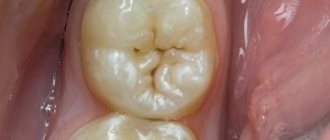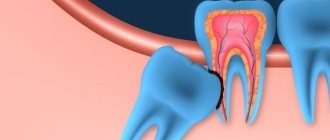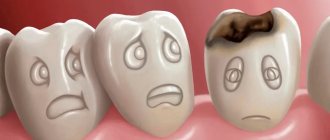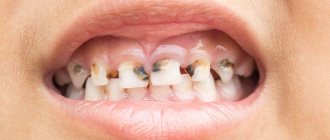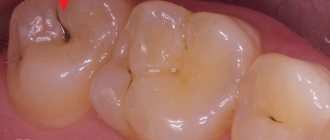From this article you will learn:
- what caries looks like under a microscope,
- about the reasons for its appearance,
- what caries leads to if left untreated.
Dental caries is a slowly occurring pathological process of destruction of hard dental tissues, developing with the participation of cariogenic bacteria in the composition of soft dental plaque. Insufficiently good oral hygiene leads to the accumulation of microbial plaque, bacteria in which metabolize food debris, turning them into organic acids. Upon contact with tooth enamel, acids dissolve its mineral matrix, which leads to “washing out” of calcium and gradual destruction of the enamel structure.
Thus, the onset of the carious process is associated with the appearance of foci of demineralization of tooth enamel, which look like white chalky spots. If the effect of organic acids continues, then this already leads to the formation of a chalky spot of a carious cavity in place - at first only in the surface defect to the depth of the enamel. In the absence of timely treatment, caries spreads to the dentin underlying the enamel. If the carious process is not treated at this stage, the infection from the carious cavity penetrates into the tooth pulp, first causing the development of pulpitis and then periodontitis.
What caries looks like: photo
However, it is worth saying that the risk of developing caries depends not only on the quality of oral hygiene. For example, there are individual characteristics inherent at the genetic level that make tooth enamel more resistant to acids. This is referred to as caries resistance, and its degree depends on the characteristics of the enamel structure in each person. The risk of caries development is also influenced by the individual characteristics of the oral fluid - the daily volume of saliva secretion, its buffer capacity (the ability to neutralize acids), and the concentration of lysozyme in it.
The development of caries is also influenced by another very important point, which concerns your eating behavior. For example, if you have the habit of snacking on chips, flour or sweets between main meals, the risk of caries becomes maximum even if the tooth enamel is highly caries-resistant. The same applies to frequent consumption of acidic and sugar-containing drinks, such as fruit juices or sweet soda. Accordingly, there are certain rules that a person must follow in order to reduce the risk of developing caries, and these rules apply not only to the normalization of oral hygiene. Read more about this in the article:
→ Prevention of caries development
What causes dental caries?
Caries is a progressive disease that destroys the hard tissues of the tooth. Cariogenic bacteria live in the oral cavity; they form a biological film on the surface of the teeth - dental plaque. They feed on carbohydrates that enter our bodies through food and drinks. Bacteria process sugars and produce organic acids. Those, in turn, corrode tooth enamel and deep tooth tissues. This is how caries develops.
In this article
- What causes dental caries?
- How does caries progress?
- A dangerous complication of caries is pulpitis.
- How is pulpitis treated?
- Periodontitis as a dangerous consequence of caries
- How is periodontitis treated?
- What is the danger of caries for the gastrointestinal tract?
- ENT diseases as consequences of caries
- Why is caries dangerous for the heart and blood vessels?
- Risk of death from dental caries
- Conclusion
Although bacteria living in the oral cavity play an important role in the development of carious lesions, a complex of unfavorable factors is important for tooth decay:
- an abundance of “fast” carbohydrates in the diet (sweets, flour);
- poor dental and oral hygiene;
- lack of calcium, fluorine, phosphorus, vitamin D in the body;
- weakened immunity.
How does caries progress?
There is a myth that caries is necessarily a hole in the tooth, but in reality, dental disease begins with the loss of mineral substances in the tooth enamel and gradually progresses. Caries goes through four stages in its development. Let's look at them below.
- Spot stage.
There is no hole in the tooth yet, but a whitish spot is noticeable on the surface. A change in the color and structure of the enamel means that it is losing minerals in this area. At an early stage there is no pain or discomfort, so patients rarely go to the dentist, not even suspecting the presence of caries. But it is at the spot stage that caries is easiest to cure. The progression of the disease can be stopped using conservative methods without drilling or installing a filling. At this stage, remineralization, simple and deep fluoridation, and the infiltration method are effective.
- Superficial caries.
At this stage of development of the disease, a small carious cavity forms within the enamel. The patient may have the first complaints: the tooth reacts to cold and hot, sour and sweet, food gets stuck in the resulting hole.
- Average caries.
The carious cavity becomes larger and affects the dentin - the bone tissue of the tooth under the enamel. At this stage, acute toothache most often appears; food stuck in the hole causes severe discomfort, and the patient complains to the dentist. It will not be possible to cure average caries without preparing the tooth, so an operative approach is used in treatment - using a drill, the affected tissue is removed and the cavity is filled with special composite materials.
- Deep caries.
The carious lesion affects the deepest layers of dentin and approaches the dental nerve. All the symptoms that were there before intensify, sometimes becoming chronic. Frequent complications of deep caries are pulpitis and periodontitis (inflammation of the pulp and tissues surrounding the tooth root).
It is better to treat caries in the early stages, while there is no carious cavity in the tooth. Conservative methods will help stop the pathological process without drilling and filling. If a hole has already formed in the tooth, then you cannot do without a drill. What if you don't treat it? Many people have been afraid of dentists since childhood and put off visiting the doctor as much as possible. This should not be done under any circumstances, because caries is dangerous for the body due to its consequences. With an advanced form of the disease, you can lose a tooth or develop purulent inflammation. There are even cases of death from complications of deep caries. Therefore, it is imperative to treat the disease!
Symptoms
The initial stage of the disease is characterized by mild symptoms. The patient is not bothered by pain. The lesion rarely causes discomfort, soreness or unpleasant sensations when eating too spicy, salty, sour, or sweet foods. In the acute course of the pathological process, the formation of a chalky spot occurs at the initial stage; in the chronic case, a brown, dark spot occurs.
Caries in the spot stage often causes an aesthetic defect, especially if the lesion is located on the front teeth. A white spot can be localized in any part of the tooth, but is most often observed in the cervical area. Caries in the stain stage can be located under dental plaque, so it is detected during professional hygiene and preventive examination.
A dangerous complication of caries is pulpitis.
The most common consequence of untreated caries is pulpitis. It occurs when the infection extends beyond the tooth and spreads to the pulp - the neurovascular bundle, or dental nerve.
The pulp contains nerves and blood vessels and provides nutrition to the dental tissues. Therefore, with pulpitis, the tooth may lose vitality. In severe cases, inflammation spreads to neighboring tissues.
A characteristic symptom of pulpitis is acute, prolonged pain that is difficult to tolerate. It often has a pulsating nature and can radiate to the temple, ear, or throat. The peculiarity is that attacks of pain appear at certain intervals, last about 5 minutes, and can intensify when lying down. It is necessary to begin treatment of pulpitis as quickly as possible.
How is pulpitis treated?
Pulpitis can be treated biologically or surgically. The first is applicable if the disease is in its early stages. The dentist strives to preserve the pulp by eliminating only the inflammation. If possible, pulpitis of primary teeth is treated using a biological method, when it is especially important to preserve the tooth root. Treatment is carried out in several stages. First, the dentist prepares the carious cavity, opening it as wide as possible. Then he treats it with an antiseptic, puts a swab with an antibacterial agent and covers the tooth with a bandage. During the next appointment, if the patient has no complaints, the cavity is treated with medication, filled with a special composition that stimulates dentin production, and a temporary filling is placed for a period of 5 to 7 days. During the third appointment, the dental crown is filled.
When the biological method of treating pulpitis is ineffective, surgical treatment is used. In this case, the inflamed neurovascular bundle is removed completely or partially. Without a nerve, a tooth becomes unviable and its service life is reduced.
Surgical treatment is performed with local anesthesia. First, the carious cavity is prepared, the pulp is removed, the affected area is treated with an antiseptic, medication is injected, and first the root canals are filled, and then the dental crown. As with the biological method, surgical treatment is carried out over several visits to the dentist.
If pulpitis is not treated, it will progress and can lead to very serious complications:
- flux - inflammatory process in the periosteum;
- periodontitis - inflammation of the tissues surrounding the tooth;
- pulp necrosis - death of its cells;
- sepsis is a blood infection that can develop when an infection enters the bloodstream.
You can avoid such complications if you do not delay your visit to the dentist and begin treatment for the disease at the first symptoms.
Diagnostics
Diagnostics is an important stage of the examination, with the help of which the doctor will accurately diagnose and determine the treatment method for caries in the spot stage. The dentist conducts a clinical examination, probing, thermal diagnostics and various diagnostic tests.
When probing, a rough enamel surface is determined. Thermal tests are negative, that is, pain does not occur when exposed to cold or hot water. In some cases, radiography is performed to rule out periodontal disease.
Samples are necessary to differentiate caries in the spot stage from hypoplasia, fluorosis and other non-carious defects. Before using dyes, the tooth is cleaned and any dental deposits are removed. The enamel is dried and a special preparation is applied (methylene blue or red, tropeolin, carmine). The stage of caries development and the boundaries of its distribution are determined by the degree of staining of the defect. Non-carious defects are not stained with dyes, so the doctor excludes them.
Periodontitis as a dangerous consequence of caries
Against the background of untreated caries and dental pulpitis, the infection penetrates even deeper. As a result, periodontitis develops. This is a disease in which the tissue around the tooth root becomes inflamed - periodontium. Essentially, it is a ligamentous apparatus that holds the tooth in the jaw and provides shock absorption. With periodontitis, an abscess may form near the diseased tooth, and in this case, treatment will require opening the tooth and cutting the gum.
Periodontitis can occur in acute and chronic forms. Acute is characterized by a rapidly developing inflammatory process. The tooth darkens, becomes loose, the patient complains of acute pain, inflammation of the cheek may occur, and swelling appears in the area of the affected tissue. In a chronic course, pronounced symptoms may be absent, and pain occurs only during periods of exacerbation. Chronic periodontitis requires long-term complex therapy, which can take several months. The disease greatly weakens the immune defense and generally negatively affects the condition of the body.
How is periodontitis treated?
The approach to treating periodontitis may vary depending on its type, severity, patient history and other factors.
The chronic form of the disease is treated according to the following scheme:
- The area of the diseased tooth is numbed with anesthetics.
- First, the affected tissue and old fillings are removed from the root canal, the tooth is depulped, and, if necessary, the root canal is expanded using dental drills or a microscopic incision.
- At the second stage, the root canal is cleaned and washed with antiseptic solutions. An antibacterial drug is placed into the canal cavity, which relieves the inflammatory process and fights infection.
- The tooth is covered with a temporary filling, and antibacterial and anti-inflammatory drugs are prescribed.
- The patient is sent home, where he must strictly follow all the dentist’s recommendations. The next appointment is usually scheduled after three or four days.
- At the second stage of treatment, a control photograph is taken. If the inflammation is stopped, the dentist removes the temporary filling and medicine from the root canals, rinses the cavities with an antiseptic, and fills the canals with a special composite material. It contains substances that help restore dental tissues and destroy pathogenic microorganisms. This filling of the canals is temporary and is needed in order to completely stop the inflammation and reduce the risk of re-developing periodontitis in the future. It is done for several months, and the tooth is again covered with a temporary filling.
- A few months later, the patient comes for a follow-up appointment with the dentist, where a tooth photograph is taken again to evaluate the effectiveness of the treatment. If the inflammation has completely stopped, the final stage of treatment begins - replacing temporary fillings with permanent ones and restoring the dental crown with a permanent light-curing filling. After this, the process of treating chronic periodontitis is considered complete.
- Unfortunately, it is not always possible to carry out conservative treatment of this disease. In advanced forms, the dentist is forced to resort to surgical treatment, when part of the root or the entire tooth is removed.
Treatment of periodontitis is long, complex and expensive, and the disease itself is a source of chronic infection, negatively affects the entire body, and weakens the immune system. It is easier and safer to contact the dentist on time and treat early caries. The consequences of an advanced disease are dangerous for the body.
Granuloma
Granuloma is advanced periodontitis. Symptoms of the process:
- A purulent sac in the periapical area, which is visible on x-ray.
- The process does not give a clearly defined clinical picture for a long time.
- If the process worsens, then unbearable pain is observed.
Treatment consists of delayed filling of the root canal with a temporary calcium-based filling material. This material in the canal used for filling is periodically renewed, usually after six months the granuloma resolves. If not, then a resection of the apex of the tooth root is performed, along with the granuloma.
What is the danger of caries for the gastrointestinal tract?
Caries and its complications have a harmful effect not only on teeth, but also on other organs and systems of the body. In particular, diseases of the gastrointestinal tract - pancreatitis, gastritis, duodenal and stomach ulcers - often occur against the background of dental caries.
The fact is that with caries and any other dental diseases, pathogenic microflora is activated in the oral cavity. Together with food and saliva, it can easily penetrate the esophagus into the stomach and intestines, causing an inflammatory process. As microbes multiply, they crowd out beneficial microorganisms and lead to the development of gastrointestinal diseases. On the other hand, the state of the digestive organs directly depends on the quality of chewing food. Caries negatively affects this function, because with damaged chewing teeth a person cannot efficiently process food to such a state that the gastrointestinal tract can easily absorb and digest it. As a result, there is an excess load on the stomach, intestines, and duodenum, which leads to pathologies of the digestive organs. In addition, poorly chewed food makes it worse for nutrients to be absorbed.
Modern research shows that even deposits on healthy teeth can threaten the health of the stomach and intestines. Thus, the bacteria Helicobacter pylori accumulate in tartar, which contributes to the development of peptic ulcers. Therefore, not only timely treatment of caries, but also its prevention, in particular proper and regular oral hygiene, helps reduce the risk of gastrointestinal diseases.
Treatment at home
Some procedures to eliminate the disease can be performed at home. To do this, you need to visit a specialist who will carry out professional hygiene and prescribe procedures. Treatment of enamel caries in the stain stage can be carried out using professional means: toothpastes, gels, applications. Very popular and quite effective are remineralizing gels (TOOTH MOUSSE, ROCS Medical Mineral and others), medicated toothpastes with a high content of fluoride and calcium (ROCS Medical, Elmex, Biorepair).
The products are used for cleaning teeth, and also in the form of applications - applied to the required surface for 5-10 minutes daily for 1-2 weeks. The active components of the products penetrate into the lesion, promote its remineralization - restoration of the structure with mineral substances.
Self-treatment of caries without consulting a specialist is most often ineffective; the carious process does not stop and affects the underlying tissues. The therapy procedure is quite serious and requires precise, correct implementation of the dentist’s prescriptions.
The use of traditional medicine, unfortunately, will not help eliminate carious defects. There are no herbs or remedies that can stop the disease. Some traditional medicine recipes have an antiseptic, anti-inflammatory effect, and therefore can only improve the general health of the oral cavity.
Why is caries dangerous for the heart and blood vessels?
When brushing your teeth, there is a risk of injury to your gums. This can happen due to a brush that is too hard, careless use of dental floss, or sensitivity of the gums themselves. One way or another, cariogenic bacteria enter the resulting wounds, which can be carried throughout the body by the bloodstream. If they get into the tissue of the heart, inflammation of its valves may develop - infective endocarditis.
Studies show that with advanced caries, the risk of developing cardiovascular pathologies increases by 70%. When bacteria enter the blood, they settle on the vascular walls next to atherosclerotic plaques. As a result, the plaque begins to actively grow and can clog the vessel, disrupting normal blood flow. The most dangerous consequences can be thrombosis, stroke, heart attack, atherosclerosis.
Risk of death from dental caries
Many people underestimate the danger of caries, considering this disease to be frivolous. However, there are known cases of death from complications of untreated caries. How is this possible?
For example, if the inflammatory process from the roots of the teeth of the upper jaw spreads to the maxillary sinuses, sinusitis may occur, which can spread greatly without treatment. When the infection extends beyond the jaws, there is a possibility of a brain abscess, purulent inflammation, sepsis - all these complications can be fatal.
Another danger is the so-called pathological fracture of the jaw. This condition is associated with a cyst in the jaw, which occurs as a complication of advanced caries.
All of these dangers are real and can occur against the background of dental caries. But it is important to understand: only an advanced carious process that has not been treated for many months or even years leads to such serious complications. With regular visits to the dentist, timely treatment of caries at the first symptoms, as well as compliance with the rules of dental hygiene and other preventive measures, the risk of serious consequences for the body is almost zero.
Causes
The most common reason is poor quality treatment at initial treatment. To prevent relapse during the preparation process, it is necessary to remove all affected tissue and treat the cavity. If there is an area of damaged enamel or dentin left, or if bacteria gets under the filling, the disease will develop again over time. A good dentist is always careful when drilling a tooth; after the process is completed, he will make sure that there is no destroyed tissue left, and then he will carry out a thorough antiseptic treatment of the hole.
Another mistake doctors make is incorrect installation of the filling. The material should fit tightly, without the slightest gaps, to the enamel and dentin. If air or liquid gets under the filling, this is the entrance gate for streptococcus, which causes the carious process. The use of high-quality materials and proper preparation of the hole before restoration allow you to avoid troubles. Low-quality filling materials have an unpleasant feature - over time they decrease in volume. As a result, the filling, which was installed according to technology and was airtight, begins to lag behind the base, a gap is formed, and infection penetrates through it.
Secondary caries can also occur due to the patient’s fault. The integrity of the seal may be compromised for the following reasons:
- eating solid foods;
- smoking;
- improper oral care, ignoring daily hygiene procedures;
- eating cold with hot;
- mechanical damage.
The risk of the disease is also high in people suffering from bruxism. Constant pressure leads to cracking of the seal, breaking its tightness.
The durability of the filling is on average 5 years. If it stands longer than this time, even the quality of the material and adherence to technology do not guarantee tightness.



